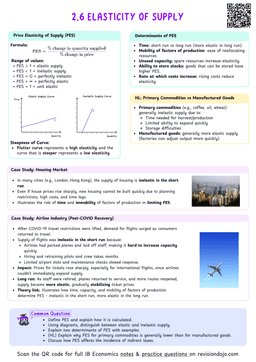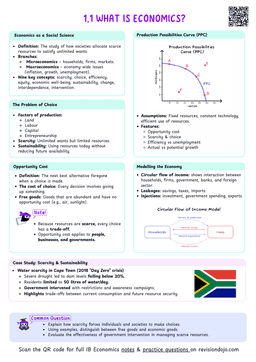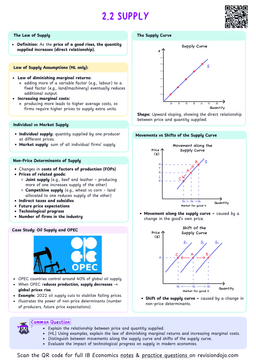In section 3.2.5, we introduced the difference between the short-run and long-run in macroeconomics:
- In the short-run, the cost of factors of production (especially wages) are fixed (they are not affected by changes in price levels).
- In the long-run, the costs of factors of production are variable (they adjust to the price level).
There two main different views on how the aggregate supply looks like in the long-run:
- The monetarist/new classical view.
- The Keynesian view.
There is not a "correct" view on the aggregate supply. Throughout the IB Economics course, you can use both interchangeably, as you may prefer.
Monetarist/new classical view of the long-run aggregate supply (LRAS) curve
- The monetarist/new classical approach to aggregate supply focuses on the distinction between the short run and long run in macroeconomics.
- It advocates that there is a different relationship between the aggregate supply and price level in the long-run and the short-run.
- The relationship between the price level and aggregate supply in the long run is represented by the long-run aggregate supply (LRAS) curve (Figure 1 below).
As can be seen by Figure 1 above:
- The LRAS curve is vertical at potential output (Yp).
- Potential output is the level of output an economy produces in the long run, when all costs of production are variable.
In Price Level vs Total Output diagrams, you can label the 'X axis' as:
- Real GDP.
- Y.
This is because, as we saw in our discussion of national income accounting, the national income (Y) = national output (real GDP).
Why is the LRAS curve vertical?
- In the long run, over time, wages and all other costs of factors of production prices adjust to match the changes in the price level. For example:
- If the price level rises, workers demand higher wages to keep up with the increase in price level (inflation).
- If the price level falls, resource prices decrease proportionally, and firms also decrease wages to maintain profit margins.
- Therefore, when wages and input prices fully adjust to match the price level changes, firms’ real costs of production stay the same: the price level has changed, but the profitability of producing goods remains constant.
- With constant real costs and profits, firms have no reason to increase or decrease their output.
- Therefore, the total quantity of output produced in the long run remains the same, regardless of changes in the price level.
- This lack of change in output as the price level changes explains why the LRAS curve is vertical.
We will explore the level of output an economy produces in the long run, known as potential output (Yp), in section 3.2.9.
Keynesian view of the AS curve
NoteThe Keynesian branch of economics receives its name after British economist John Maynard Keynes (1883-1946). His groundbreaking work, particularly The General Theory of Employment, Interest, and Money (1936), revolutionised economic thought by emphasising the role of government intervention in stabilising economies during recessions. His ideas laid the foundation for modern macroeconomics and continue to influence economic policies worldwide.
- The Keynesian approach to aggregate supply focuses on the idea that resource prices (especially wages) cannot fall, even after long periods of time.
- It advocates that there is an inability for an economy to move into the long run when there is a downward price level pressure.
- The Keynesian view on the relationship between the price level and aggregate supply is represented by the Keynesian aggregate supply (AS) curve (Figure 2 below).
As shown in Figure 2 above, the Keynesian AS curve has three distinct sections:
- Horizontal section:
- At low levels of output, the curve is horizontal.
- This is because, at low levels of output, there is significant underutilisation of resources in the economy.
- Therefore, firms can expand production without increasing wages or input costs because of the abundance of unused resources.
- Upward-sloping section:
- As the economy continues increasing its output, the AS curve begins to slope upwards.
- This is because, in this range, some resources become scarce. Therefore, Firms must compete for scarce resources, pushing up wages and input prices and rising costs of production.
- In order to maintain profit margins, firms must raise their final prices, leading to increases in the price level as firms increase their aggregate output.
- Vertical section:
- When the economy expands beyond its potential output ($Y_p$), the curve becomes vertical.
- At this point, all the available resources are employed, and the rate of unemployment is zero, not the natural rate of unemployment that occurs at $Y_p$. Therefore, firms cannot increase their real output.
- Additionally, as the price level rises continues rising, workers demand higher wages to keep up with the increases in price level, which in turn forces firms to increase further their final prices.
- Resultantly, the price level increases without leading to increases in real output.
Explaining the Keynesian AS curve through a fictitious example
Imagine a fictitious economy, Econland:
- At first, Econland is producing at low level of output:
- Many people are unemployed, so they are willing to take any small wage for their job (it is better than being unemployed).
- Therefore, firms can initially hire a lot of workers without needing to increase their wages.
- Since firms do not charge more for their output, because their costs of production are low, the economy increases its real output without leading to increases in price level (horizontal section of the curve).
- Econland continues producing more real output:
- As firms hire more workers at low wages to increase their production, less and less people are unemployed.
- Therefore, workers begin to become scarce, so firms must increase the wages they offer to attract more workers.
- Hence, in order to maintain profit margins, firms must also raise the final prices of their output.
- Resultantly, as Econland produces more and more output, the price level increases more and more (upward-sloping section of the curve).
- Econland continues producing even more:
- As Econland produces more and more, the unemployment level in the economy reaches the natural rate of unemployment.
- Therefore, (almost) all the available workers are employed, and so firms cannot hire more workers, which means they cannot increase their real output either.
- Additionally, as the price level rises continues rising, workers demand higher wages to keep up with the increases in price level (inflation).
- Resultantly, as Econland reaches their full employment of resources (at the natural rate of unemployment), the price level increases without leading to increases in real output (vertical section of the curve).


